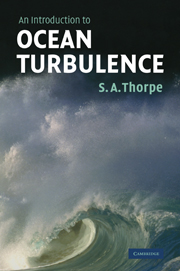Book contents
- Frontmatter
- Contents
- Preface
- Notes on the text
- Acknowledgements
- Abbreviations
- Standard parameters and symbols
- Units and their symbols
- SI prefixes
- Approximate values of commonly used measures
- 1 Turbulence, heat and waves
- 2 Measurement of ocean turbulence
- 3 Turbulence in oceanic boundary layers
- 4 Turbulence in the ocean pycnocline
- 5 Turbulent dispersion
- 6 The energetics of ocean mixing
- References
- Index
- Answers
2 - Measurement of ocean turbulence
Published online by Cambridge University Press: 05 June 2012
- Frontmatter
- Contents
- Preface
- Notes on the text
- Acknowledgements
- Abbreviations
- Standard parameters and symbols
- Units and their symbols
- SI prefixes
- Approximate values of commonly used measures
- 1 Turbulence, heat and waves
- 2 Measurement of ocean turbulence
- 3 Turbulence in oceanic boundary layers
- 4 Turbulence in the ocean pycnocline
- 5 Turbulent dispersion
- 6 The energetics of ocean mixing
- References
- Index
- Answers
Summary
Measurement is at the heart of science. The measurement of turbulence in the ocean has proved difficult, and not all the technical and operational problems have been overcome. In this chapter we review the characteristics that are used to describe turbulent motion and its effects, and describe some of the methods of measuring and quantifying turbulence.
Characteristics of turbulence
Some of the characteristics of turbulence are described in general terms in Chapter 1. These can provide ways of quantifying turbulent motion as explained in this, and later, sections.
Structure
Figure 2.1 is a shadowgraph image of the development of a turbulent shear flow in a laboratory experiment. It shows large billows formed downstream of a ‘splitter plate’ dividing two streams of gases with different speeds and densities. As in the photograph of the surf zone (Fig. 1.4), Fig. 2.1 shows that the flow contains patterns or structures – the billows – that recur. Each billow extends over a finite region: the motions within are spatially coherent. Although the billows are transient, they also persist for times long enough to allow them to be identified: they are coherent for short periods of time. The structure within billows varies in detail from one to another, and consists of small-scale turbulent motions that lead to the fine ‘texture’ visible in the image.
Such patterns of relatively large-scale coherent eddies containing small-scale motions are commonly found in turbulent flows.
- Type
- Chapter
- Information
- An Introduction to Ocean Turbulence , pp. 37 - 76Publisher: Cambridge University PressPrint publication year: 2007



